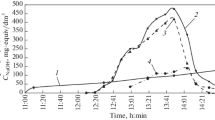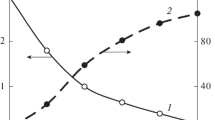Abstract
Technologies aimed at reducing the consumption of reagents and the environmental impact resulting from the operation of water-treatment equipment in the domestic power industry are analyzed. Attention is focused on the specifics of the reagents' application in membrane-separation technologies. It is noted that the membrane technologies used for water treatment frequently involve the necessity of applying chemical reagents, the ingress of which into the sewage makes the utilization of the latter more difficult and increases the environmental impacts. A conclusion about the impossibility of completely abandoning reagents for water treatment has been made. A method for the environmentally friendly, reagent-free operation of membrane-separation plants has been devised and its viability has been proven by an example of a pilot nanofiltration water-treatment unit for the heat-supply system operating with a water of the potable quality. Approaches have been outlined that allow a reduction in the water-treatment costs of thermal power plants using integrated membrane technologies and/or their combinations with ion exchange. Despite the fact that there is no possibility of completely abandoning reagents for water treatment in common cases, membrane-separation technologies currently constitute the basis for engineering solutions that allow a reduction in the water-treatment costs and even the implementation of reagent-free techniques in particular cases.


Similar content being viewed by others
REFERENCES
S. J. Severtson, P. Y. Duggirala, P. W. Carter, and P. E. Reed, “Mechanism and chemical control of C-aCO3 scaling in the craft process,” Tappi J. 82 (6), 167–174 (1999).
M. V. Rudomino and N. I. Krutikova, “Environmental aspects of the use of organophosphonates,” in Proc. Modern Technologies of Water Treatment and Protection of Equipment from Corrosion and Scale Formation, 3rd Sci.-Pract. Conf., Moscow, Sept.2009 (Travers, Moscow, 2009), pp. 32–41.
S. L. Gromov, “Reverse osmosis: How to minimize the impact on the environment?,” in Proc. Modern Technologies of Water Treatment and Protection of Equipment from Corrosion and Scale Formation, 7th Sci.-Pract. Conf., Moscow, Oct. 25–26,2017 (Travers, Moscow, 2017), pp. 57–60.
J. Josephs, “No time to whine about brine—Could Gulf states reach peak salt?,” Water World 33 (3), 28–31 (2017). https://www.waterworld.com/international/ desalination/article/16201137/no-time-to-whineabout-brine-could-gulf-states-reach-peak-salt
S. L. Gromov and M. Ya. Gromova, “The spacer for the concentrate channel of the membrane spiral wound elements,” RF Patent No. 2549846, Byull. Izobret., No. 12 (2015).
S. Gromov, “What steps can improve RO reliability and reduce operational costs?,” Ultrapure Water, April, 1–8 (2016).
Author information
Authors and Affiliations
Corresponding author
Additional information
Translated by O. Lotova
Rights and permissions
About this article
Cite this article
Gromov, S.L. Reagent-Free Water Treatment in the Domestic Power Industry: A Myth or a Reality?. Therm. Eng. 67, 360–364 (2020). https://doi.org/10.1134/S004060152006004X
Received:
Revised:
Accepted:
Published:
Issue Date:
DOI: https://doi.org/10.1134/S004060152006004X




